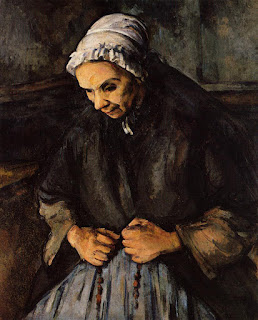 |
| Self-Portrait with Bowler Hat (1885-86) |
How do we view Cézanne? In a review of the National Portrait Gallery’s exhibition of his portraiture, the Evening Standard declared that he had no relevance to art today. This is, of course, arrant nonsense – if we were only to take the example of his influence on Matisse and then consider Matisse’s continuing influence on art, then we can see it as a piece of empty provocation.
Yet however indignantly one might reject such an assertion, there is something oddly flat about this exhibition.
That could be because it opened last year to almost universally hysterical praise and simply cannot live up to the hype.
A number of the works appear unfinished – perhaps even careless. Cézanne’s sense of proportion is, on occasion, absurd. Though I must confess that, just as with the Picasso portraits in the same rooms early last year, it is a marvellous thing for any art practitioner to see that famous artists didn’t always find it easy to paint hands!
 |
| Madame Cézanne in a Red Armchair |
It’s possible that, thinking of the Provencal sun, I had expected a riot of colour and the sharp contrasts between light and shade that one finds in southern Europe.
But Cézanne’s palette is incredibly restrained. Ironically, given such an expectation, this limited palette was actually one of the most fascinating things about the show.
Blue and blue-greens dominate. And the tones of green that the artist used on faces – Madame Cézanne in a Red Armchair (1877) is a perfect example – instantly brings to mind The Green Line (or Portrait of Madame Matisse) that Matisse painted in 1905 to huge consternation.
It’s worth remembering that Matisse was ahead of his time in recognising Cézanne – he bought Three Bathers (1879-82) at great personal cost in 1899 and carried it with him as a talisman for years, before donating it to the Museum of the City of Paris in 1936.
Three almost identical portraits of Madame Cézanne wife hang here – reunited for the first time in a century, but only serving to give a sense of at least one not really being finished.
 |
| The Artist’s Father, Reading L’Evénement |
The show opens with The Artist’s Father, Reading L’Evénement from 1866, which is wonderful – not least because of the less obvious things involved.
The newspaper had originally been Le Siècle (a republican but not revolutionary paper), but Cézanne changed that to L’Evénement – a more radical publication that had a particularly caustic art critic, who turned out to be Cézanne’s old friend and sparring partner, Zola.
Alex Danchev, in his Cézanne: A life (2013), points out that it was part of a lifetime conversation between the two.
And the artist son also makes a little point about his relationship with his father by including a painting of his own behind the chair.
Of interest is Portrait of Paul Cézanne (1862-64), painted from a photograph of the artist himself at the age of 22, which has a fierce quality that contrasts hugely with the questioning expression that is a regular feature in so many later self portraits, including a pair from 1875, Self-Portrait with a Landscape Background and Self-Portrait with Rose Background (the latter of which looks like Clement Freud).
 |
Old Woman with a Rosary
|
In another room, we have two more self-portraits – this time, both show the artist wearing a bowler hat. Again, the look is quizzical and seems to challenge the impertinence of the viewer in a way the portraits of other people never seem to do.
Woman With a Coffee Pot (1895) is striking, but more striking yet is Old Woman with a Rosary (1895-96), with light that nods to Rembrandt and a treatment of his subject that conveys real emotion.
My most substantial previous exposure to Cézanne had been at the Courtauld, which has lent this exhibition Man With a Pipe (c1896). Yet for all that it is largely executed in a palette of browns, Cézanne here gives his subject light – dappled light on the hat and coat.
And in The Gardener Vallier (1905-06), one of his last works, there are finally the brights and the light and shade one might have expected.
Much to consider and take away for further mulling, even if nothing quite leaves you with a sense of awe.
Not that anything is ever helped by curator’s notes that seem aimed directly at winning a place in Private Eye’s Pseuds Corner – the explanation for Old Woman with a Rosary waffled on about the artist using colour to show volume, with “lozonge-shaped” slabs of colour being like “a map”. No. Just no.
But perhaps what most feels disjointed here is the contrast – or even the conflict – between the more naturalistic portraits and mask-like ones; we flit between the two through Cézanne’s career.
The self-portraits are, as a group, among the strongest works on display – precisely because they veer to the more naturalistic and because of that gaze.
Never mind how we view Cézanne – this exhibition seems to be more about how the artist makes us think about ourselves when we train our own gaze on another person and, in this age of the ‘selfie’, maybe even ourselves, just as he was gazing at himself.
Until 11 February at www.npg.org.uk.

No comments:
Post a Comment